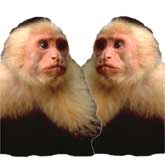Monkey See Monkey Do: Mirror Neurons May Lie At The Root Of Language
 Self-awareness, the ability to infer the mental states of others, and language are considered uniquely human cognitive skills. But they didn't spring into the human brain out of nowhere. A recently-discovered assembly of neurons called mirror neurons may shed some light on the evolution of the brain structures underlying these skills. Mirror neurons are frontal-cortex brain cells that have been found in the brains of monkeys, as well as apes and humans. They fire not only when the monkey grasps or manipulates an object, but also when the monkey just watches another monkey perform the same action. In other words, they are essential for modeling one's actions on the actions of others - commonly known as imitating.
Self-awareness, the ability to infer the mental states of others, and language are considered uniquely human cognitive skills. But they didn't spring into the human brain out of nowhere. A recently-discovered assembly of neurons called mirror neurons may shed some light on the evolution of the brain structures underlying these skills. Mirror neurons are frontal-cortex brain cells that have been found in the brains of monkeys, as well as apes and humans. They fire not only when the monkey grasps or manipulates an object, but also when the monkey just watches another monkey perform the same action. In other words, they are essential for modeling one's actions on the actions of others - commonly known as imitating.
Mirror neurons provide a bridge between seeing and doing. They may also provide a bridge between listening and speaking, and their development in the primate brain may be crucial to the development of language in humans. Even simple personal pronouns (you, me, etc.) and basic words such as here, there, come, and go have to be understood from the perspective of the person speaking them. And any rudimentary dialogue requires one conversant to project his or her mind into the mind of the other. That ability also helps us lie, cheat, and deceive, if we want to. Without the ability to infer the mental states of others, we couldn't manipulate their knowledge and beliefs to our advantage.
In monkeys, mirror neurons are located in a part of the brain corresponding to Broca's area in humans. Broca's area is one of the brain's most important language regions, which may be no coincidence. Obviously, mirror neurons are not sufficient for the development of language, but they may be necessary for it. Autism, a disorder that includes delayed language development and impaired communication abilities along with an impaired ability to infer the mental states of others, may stem in part from a malfunction of the mirror neuron assembly in a child's brain.
About the Author
David Gamon, PhD
 Dr. David Gamon, one of the original writers at ScienceIQ, studied cognitive science at U.C. Berkeley, where he received his Ph.D. in Linguistics in 1997. He is the author of many popular books about the human brain, including Building Mental Muscle, Use It Or Lose It!, and Brains That Work a Little Bit Differently. His current projects include books about gender differences in the brain, the brain’s construction of sensory reality, and psychopathy.
Dr. David Gamon, one of the original writers at ScienceIQ, studied cognitive science at U.C. Berkeley, where he received his Ph.D. in Linguistics in 1997. He is the author of many popular books about the human brain, including Building Mental Muscle, Use It Or Lose It!, and Brains That Work a Little Bit Differently. His current projects include books about gender differences in the brain, the brain’s construction of sensory reality, and psychopathy.


